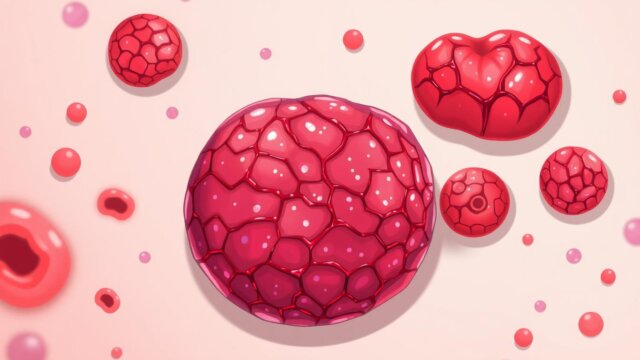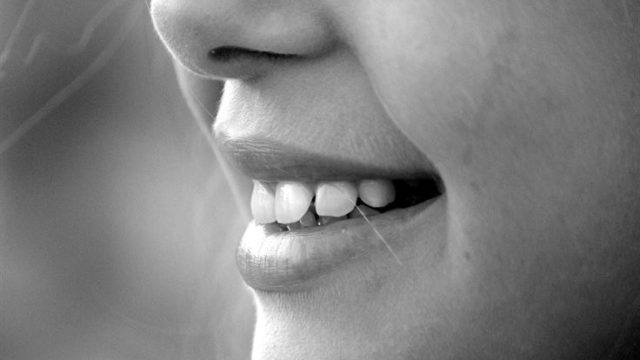FTC disclaimer: This post may contains affiliate links and we will be compensated if you click on a link and make a purchase.
Did you know there are over 150 types of headaches? Each one has its own set of symptoms and treatments. Headaches are common but can be complex, from simple tension headaches to severe migraines. Knowing the different types and what causes them is key to finding relief.
Headaches can feel like a dull ache, a throbbing, or even a sharp pain. They can vary in how they feel and how often they happen. Some are triggered by things like hormonal changes, stress, or not drinking enough water. Others might be caused by a medical condition. No matter the cause, headaches can really affect your life and daily activities.
Key Takeaways
- Headaches can be more complicated than most people realize, with over 150 different types identified.
- Certain factors, such as hormonal changes, stress, and environmental triggers, can contribute to the development of headaches.
- Identifying the specific type of headache is crucial for finding the most effective treatment and prevention strategies.
- Men are three to four times more likely to experience cluster headaches compared to women.
- Migraines may be triggered in adults by too much physical activity.
Understanding Headaches
What is a Headache?
A headache is a pain in your head or face. It’s often felt as a pressure that throbs, stays constant, is sharp, or dull. These pains vary a lot in how they feel, how bad they are, where they are, and how often they happen. Headaches are very common and most people will get them many times in their lives.
They are the most common kind of pain. They are a big reason people miss work or school, and they lead to many visits to doctors. But, most headaches are not serious. Yet, some types can show a more serious health issue.
There are over 150 types of headaches. They are put into two main groups: primary and secondary headaches. Primary headaches don’t come from another health issue. They can be caused by things like drinking alcohol, eating certain foods, smoking, not sleeping well, sitting badly, being active, or missing meals.
Secondary headaches happen because of another health problem. They can be simple to treat or very serious, like spinal headaches and thunderclap headaches.
To understand headaches, knowing the different types, what causes them, and their signs is key. This helps people find the right treatment and handle their headaches better.
Types of Headaches
Headaches fall into two main groups: primary and secondary. Primary headaches happen when pain-sensitive parts in the head don’t work right. They’re not a sign of another health issue. Secondary headaches are caused by another health problem.
Headaches can be episodic, happening now and then, or chronic, happening a lot. Chronic headaches need a detailed plan to manage the pain.
- Primary headaches include migraines, tension headaches, cluster headaches, and trigeminal autonomic cephalalgias.
- Secondary headaches can stem from things like brain tumors, strokes, blood clots, inflammation, and concussions.
Type of Headache | Prevalence | Characteristics |
|---|---|---|
Migraine | 12% of Americans suffer from migraines. Migraines are more common in women, with about 60% of women with migraines experiencing menstrual migraines. | Severe, debilitating headaches that can disrupt daily life. Migraines usually begin in the teens or twenties. Chronic migraines occur 15 or more days a month. |
Cluster Headache | Cluster headaches are three times more common in men than in women. | Occur in clusters, lasting 15 to 180 minutes and can happen up to eight times a day for four to six weeks. Cluster headaches can recur at least once during the day. |
Tension Headache | Tension headaches are the most common type of headache. | Mild to moderate pain, often described as a “tight band” around the head. Tension headaches can last hours to days. |
Hypertension Headache | Hypertension headaches occur when blood pressure reaches levels over 180/110. | Can present with vision changes, chest pain, shortness of breath, or nosebleeds. |
Seeing a doctor is key when you have symptoms that might be from secondary headaches. This helps get the right diagnosis and treatment.
Tension Headaches
Tension headaches are the most common type of headache. They affect a lot of people. These headaches make your whole head ache and can make your neck and head muscles feel sore.
Stress often causes these headaches. They can happen to anyone, but women get them a bit more often than men.
These headaches can last from 30 minutes to a week. Many people find relief by massaging their scalp or neck. Over-the-counter painkillers like aspirin or ibuprofen can also help.
There are two main types of tension headaches: episodic and chronic. Episodic ones can last up to a week. Chronic ones happen more than 15 days a month for over three months.
Women often get these headaches more than men, especially in their 40s.
Stress is the top cause of these headaches. But, doing things that involve a lot of hand use can also lead to them.
While treatment can help, chronic headaches can really affect your life. But, there are many ways to treat them, like biofeedback or massage. Learning to manage stress and taking care of your posture can also prevent it.
Migraine Headaches
Symptoms and Triggers
Migraine is a headache disorder that causes intense pain deep in the head, often on one side. These headaches can last from 4 to 72 hours if not treated, making daily tasks hard. People with migraines may feel sensitive to light and sound, and may also have nausea and vomiting. About one-third of people get visual disturbances called auras before the headache starts.
Things like lack of sleep, dehydration, certain foods, and hormonal changes can trigger migraines. Common triggers include caffeine withdrawal, hormonal changes, stress, and foods like chocolate, dairy, MSG, and foods high in tyramine.
- Migraines are more common in women than in men.
- Migraine headaches often start between ages 10 and 45.
- Migraines happen more in women than in men.
- Some women get fewer migraines during pregnancy.
Migraine Trigger | Impact |
|---|---|
Caffeine withdrawal | Can trigger migraines |
Hormonal changes | Can trigger migraines |
Stress | Can trigger migraines |
Certain foods (chocolate, dairy, MSG, tyramine-rich) | Can trigger migraines |
There are two main types of migraines: with aura (classic) and without aura (common). Symptoms can include temporary blind spots, blurred vision, eye pain, seeing stars or flashing lights, yawning, nausea, dizziness, weakness, and numbness.
“Migraines usually hurt worse on one side of the head, whereas tension headaches typically have a band of pain across the forehead or pressure on either side of the head.”
Changing your lifestyle can help reduce migraines. This includes better sleep, eating, stress management, and losing weight. To prevent migraines, doctors may suggest antidepressants, beta-blockers, anti-seizure medicines, CGRP agents, or Botox injections. For mild attacks, over-the-counter pain medicines like acetaminophen, naproxen, ibuprofen, or aspirin can help. But taking too much can cause rebound headaches.
Cluster Headaches
Cluster headaches are a rare and very painful type of headache. They are known for their severe, burning pain around one eye or on one side of the face. These headaches come in a series, lasting about 30 minutes each. During a cluster, people can get up to eight headaches in 24 hours, usually at the same time.
More men get cluster headaches than women, and they can be triggered by things like alcohol, weather, and smoking. About 1 in 5 people with these headaches have them all the time, and some might have a family history of them. People usually get them between 20 and 40 years old.
The pain from cluster headaches is so bad, it’s often called the most painful headache type. These headaches can last from weeks to months, followed by months or years without pain. Most people get headaches every day, many times a day, during a cluster.
Cluster Headache Statistics | Value |
|---|---|
The average duration of a cluster headache | 30 minutes |
Up to eight cluster headaches within a 24-hour period | |
Individuals with chronic (ongoing) cluster headache attacks | Approximately 1 in 5 |
Genetic factors present in people with cluster headaches | Up to 5% |
The risk age group for cluster headaches | 20-40 years old |
Cluster headaches are a tough type of headache, with their own set of symptoms and big impact on people’s lives. Knowing about them is key to helping manage and find relief.
Sinus Headaches
Distinguishing Sinus Headaches
Sinus headaches come from inflamed sinuses. They cause deep pain in the cheekbones, forehead, or nose bridge. You might also have a runny nose, feel ear fullness, have a fever, and see a swollen face.
Not all headaches from sinus infections are true sinus headaches. True ones have yellow or green discharge, unlike other headaches. Many people confuse sinus headaches with migraines or tension headaches.
Anyone can get sinus headaches, but some are more likely if you have a history of migraines or headaches. If your family has migraines or headaches, or if you have hormonal changes, you might get them too. Most sinus headaches aren’t from infections and don’t need antibiotics.
In rare cases, surgery might be needed for sinus headaches. A special device that sends out tiny electrical waves can also help with the pain. But, using too many medicines can lead to headaches from taking too much. Using decongestants too much can make things worse and might raise your blood pressure.
Exercise can help reduce tension and stop headaches, including sinus ones. Staying at a healthy weight through exercise can also help lower your chance of headaches.

Other Types of Headaches
There are many headache types beyond the usual ones like tension and migraine. These include ice pick headaches, thunderclap headaches, hemicrania continua, exertion headaches, and medication overuse headaches.
Ice pick headaches are sudden and very sharp, lasting just a few seconds. Thunderclap headaches are super intense and hit their peak in 60 seconds. They can warn of a serious health issue. Hemicrania continua is rare and means constant pain on one side that gets worse with some activities.
Exertion headaches come from doing too much physical activity, like running or lifting weights. They can last from minutes to days. Medication overuse headaches happen when you take pain meds too often. This can make your headaches worse.
These headache types are not as common as migraines or tension headaches but can be just as bad. They might need special doctor care. Knowing about these headaches helps doctors give the right treatment.
Headache Type | Prevalence | Characteristics |
|---|---|---|
Ice Pick Headaches | Less common | Sudden, severe, and stabbing pains that last only a few seconds |
Thunderclap Headaches | Rare | Extremely intense headaches that reach maximum intensity within 60 seconds, often signaling a serious underlying condition |
Hemicrania Continua | Rare | Continuous, one-sided pain that may worsen with certain activities |
Exertion Headaches | Less common | Triggered by physical activities, such as running or weightlifting, and can last from a few minutes to a couple of days |
Medication Overuse Headaches | Relatively common | Occur when an individual takes pain medication for headaches too frequently, leading to a cycle of worsening symptoms |
Even though these headaches are not as common, they can still really affect someone’s life. It’s key to see a doctor fast and work with them to find out why and how to treat it.
“Understanding the various headache disorders and their unique characteristics is essential for accurate diagnosis and effective treatment.”
Causes of Headaches
Headaches can come from many things, both main and secondary. Primary headaches don’t have a hidden medical cause. They can be set off by stress, bad sleep, some foods, or the environment. Secondary headaches happen because of another medical issue, like an infection, illness, head injury, high blood pressure, or other problems.
Genetics also matter for getting headaches, especially for migraines which often run in families. Migraines hit adult women three times more than men. There’s also a link between migraines, cluster headaches, and sleep quality and amount, as these affect how we move through different sleep stages.
Other common reasons for headaches include:
- Grinding teeth at night (bruxism), which can cause dull, aching headaches
- Being in bright lights and glare, especially if they flicker, can start migraines
- Eating certain foods, like aged cheeses, diet fizzy drinks, and processed meats and fish, which can bring on migraines
- Not having enough oxygen in people with sleep apnea, which may cause early morning headaches
Finding out what causes a headache is key to treating it. Keeping a headache journal can help figure out the cause. Medical tests, like blood and urine tests, can also spot any hidden medical issues.
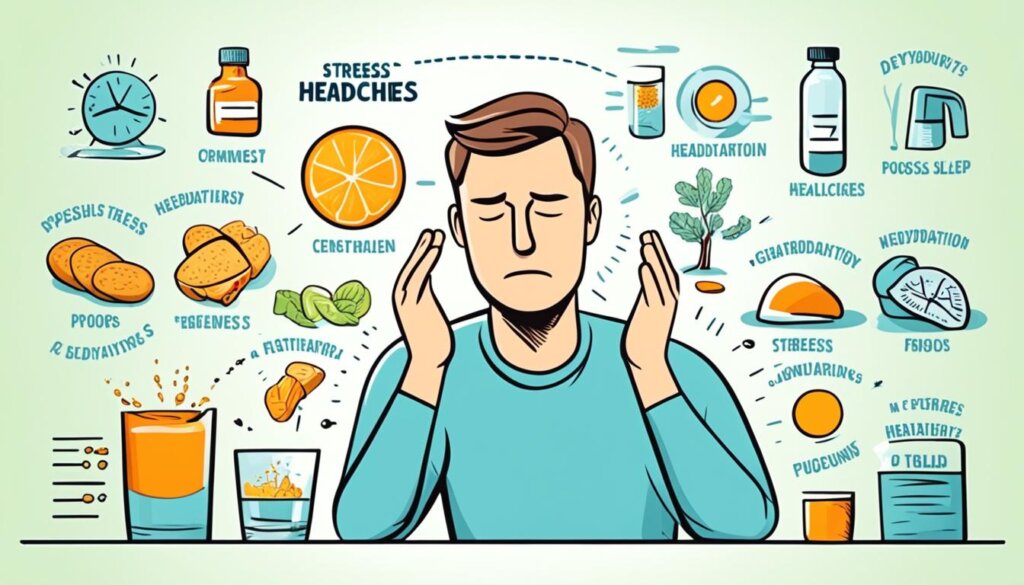
In short, headaches can stem from many things, like stress, bad sleep, genetics, and medical conditions. Knowing the causes is the first step to managing and stopping headaches.
Headache Symptoms
Identifying Headache Symptoms
Headaches can show many symptoms, based on the type. Knowing the symptoms of different headaches helps pick the right treatment.
Tension headaches give you a dull ache all over your head. Migraines bring on severe, throbbing pain on one side. They also make you sensitive to light and sound, and you might feel nauseous or vomit. Cluster headaches cause intense pain around one eye. You might see your eye get red, water, and feel your nose get stuffy on that side.
Sinus headaches hurt deeply in your cheeks, forehead, or nose bridge. You might also have a runny nose and feel feverish. Other headaches can have sudden, sharp pain or make you feel confused.
Headache Type | Typical Symptoms |
|---|---|
Tension Headache | Dull, aching pain across the entire head |
Migraine | Throbbing, severe pain often on one side of the head, sensitivity to light and sound, nausea, vomiting |
Cluster Headache | Intense, burning or piercing pain around one eye, eye redness, watering, nasal congestion |
Sinus Headache | Deep, constant pain in the cheeks, forehead or bridge of the nose, runny nose, fever |
Knowing what a headache feels like helps you get the right treatment. If your headaches are bad, keep happening, or worry you, see a doctor.
Managing Headaches
Handling headaches well means using both over-the-counter and prescription drugs, and making lifestyle changes. For mild, occasional headache treatment, over-the-counter pain relievers like acetaminophen, ibuprofen, or naproxen can help. Prescription drugs, such as triptans, ergots, and anti-seizure drugs, work better for migraine headaches.
For cluster headaches, oxygen therapy and certain injectables might be used for headache management. Making lifestyle changes like managing stress, getting better sleep, and eating right can also help prevent or ease headaches. It’s important to work with your doctor to find the best headache management plan.
Some things can cause headaches, like tight ponytails, hats, and other tight things. Bright or flickering lights, like from computers, can also trigger migraines. Using blackout curtains, sunglasses, anti-glare screens, and special light bulbs can help. Also, chewing gum, grinding teeth, and eating crunchy or sticky foods can make headaches worse.
Not drinking enough water can cause or make headaches worse. A little caffeine can help ease headache pain and make over-the-counter headache medications work better. Techniques like meditation and relaxing muscles can help with stress headaches. Massaging your forehead, neck, and temples can also ease tension headaches.
For chronic daily headaches, preventive therapy might help, including a mix of medications. Things like acupuncture, biofeedback, massage, and supplements like Coenzyme Q10 and magnesium sulfate might help some people, but be careful since not all have been well-studied. Cognitive behavioral therapy can also lessen headache frequency and intensity. Support groups or counseling can help with the mental side of chronic headaches.
When using over-the-counter headache medications, always follow the label and guidelines. Choose liquid forms for quicker absorption and avoid NSAIDs if you have heart or kidney problems. See a doctor right away for headaches after head injuries, if you feel dizzy or have weird neurologic symptoms, if headaches get worse even with medicine, or if you have any other worrying signs.

When to Seek Medical Attention
Most headaches are not serious and can be handled with over-the-counter meds or lifestyle changes. But, there are times when you should get medical help right away.
If you get a sudden, severe headache or the worst headache ever, go to the emergency room. Headaches with high fever, numbness, weakness, confusion, trouble speaking, or vision changes are serious. They need quick medical help.
Headaches that happen often, are very bad or don’t get better with over-the-counter meds might mean a health issue. Tension headaches, migraines, and headaches from too much medicine can be treated by a doctor.
If headaches bother you a lot or stop you from doing daily things, see a doctor. They can find out why and help you with a treatment plan.
Even though most headaches aren’t serious, knowing when to get medical help is key. Getting the right care can help you feel better and avoid problems.
Headaches
Headaches can be mild or very painful, like a migraine. The American Migraine Foundation says over 38 million Americans get migraines. Women get them three times more than men. These headaches usually hit people between 10 and 40 years old. Family history is key, with most people having a family link to migraines.
Many things can cause headaches, like being sick, stressed, or reacting to the environment. Hormone changes, skipping meals, and weather can also trigger migraines. Foods like aged cheese and chocolate can cause them too. Too much caffeine or stopping suddenly can also lead to headaches.
Knowing what causes your headaches helps find the right treatment. This might be over-the-counter or prescription drugs, changing your lifestyle, or a mix of things. Doctors often use certain medicines to prevent migraines. You can also try vitamins, herbs, and relaxation to help.
If your headache is bad or doesn’t go away, see a doctor. Migraines are common and often run in families. Some people get warning signs before a migraine.
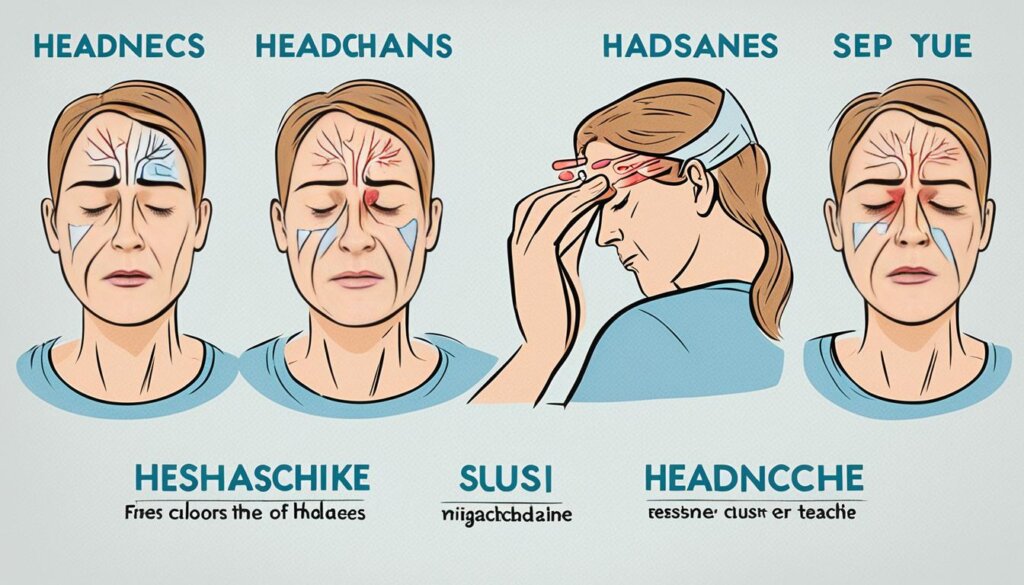
Managing headaches can make life better. By knowing about different headaches, their causes, and treatments, you can find relief. This helps you avoid headaches from getting in the way of your life.
Conclusion
Headaches are a common issue that can really affect your day. Headaches are the most common kind of pain. They’re a big reason people miss work or school or see a doctor.
Knowing about the different kinds of headaches, what causes them, and how to treat them is important. Tension headaches are the most common type. Making lifestyle changes, learning to relax, and using pain relievers can help a lot.
Most headaches aren’t serious, but some types need quick doctor’s care. Some headaches can signal serious health issues. If you have severe symptoms, see a doctor right away. Working with your doctor and using the right strategies can help you manage your headaches better.
Handling headaches can be tough, but you can find relief with the right steps. You can try changing your lifestyle, taking medicine, or getting advice from a doctor. There are many articles and studies on headaches. They offer great advice and help for those fighting this common health problem.
FAQ
What is a headache?
A headache is a pain in your head or face. It can feel like a throbbing, constant, sharp, or dull pressure. Headaches vary in pain type, severity, location, and how often they happen.
What are the main types of headaches?
Headaches fall into two main groups: primary and secondary. Primary headaches come from pain-sensitive parts in the head acting up. They don’t point to another medical issue. Secondary headaches are caused by another medical condition.
What is a tension headache?
Tension headaches are the most common type. They make your whole headache and can make your neck, forehead, scalp, or shoulders hurt.
What are the symptoms of a migraine?
Migraines cause intense pain deep in the head, usually on one side. They make you sensitive to light and sound. Some people also get visual disturbances before the headache starts.
What are cluster headaches?
Cluster headaches give you severe pain around or behind one eye. They can happen in a series, lasting from 15 minutes to 3 hours.
How are sinus headaches different?
Sinus headaches come from inflamed sinuses. They cause deep pain in your cheekbones, forehead, or nose bridge. You might also have a runny nose, feel like your ears are full, have a fever, and your face might swell.
What causes headaches?
Many things can cause headaches, both primary and secondary. Primary headaches aren’t from another medical issue but can be triggered by stress, sleep issues, certain foods, or environmental factors. Secondary headaches are from an underlying medical condition, like an infection, illness, injury, high blood pressure, or other issues.
How can I identify the symptoms of different types of headaches?
Headache symptoms vary by type. Tension headaches give you a dull ache all over your head. Migraines cause severe pain on one side, making you sensitive to light and sound, and causing nausea and vomiting. Cluster headaches bring intense pain around one eye, with eye and nose symptoms. Sinus headaches cause deep pain in your face, along with sinus symptoms like a runny nose and fever.
How are headaches treated?
There are many ways to treat headaches. For mild, occasional headaches, over-the-counter pain relievers work well. Prescription drugs are better for migraines. Cluster headaches might need oxygen therapy and injectable medications. Changing your lifestyle to manage stress, sleep better, and eat differently can also help prevent or ease headaches.
When should I seek medical attention for a headache?
Most headaches aren’t serious and can be handled with over-the-counter meds or lifestyle changes. But, see a doctor right away if your headache is severe, lasts a long time, or has worrying signs like sudden start, extreme pain, fever, stiff neck, or changes in your brain function.

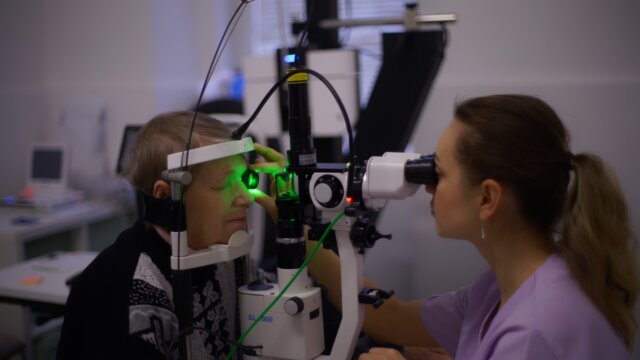
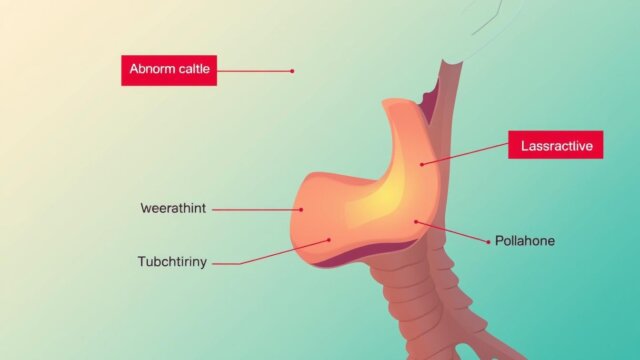
![5 Quick Natural Ways to Fight Cold and Flu [Natural Remedies]](https://healthyious.com/wp-content/uploads/2019/11/5-Quick-Natural-Ways-to-Fight-Cold-and-Flu-Natural-Remedies-640x360.jpg)
